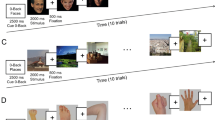Summary
The pattern of visually induced local metabolic activity in the optic lobes of two structural mutants ofDrosophila melanogaster is compared with the corresponding wildtype pattern which has been reported in Part I of this work (Buchner et al. 1984b). Individualoptomotor-blind H31 (omb) flies lacking normal giant HS-neurons were tested behaviourally, and those with strongly reduced responses to visual movement were processed for 3H-deoxyglucose autoradiography. The distribution of metabolic activity in the optic lobes ofomb apparently does not differ substantially from that found in wildtype. In the mutantlobula plate-less N684 (lop) the small rudiment of the lobula plate which lacks many small-field input neurons does not show any stimulus-specific labelling. The data provide further support for the hypothesis that small-field input neurons to the lobula plate are the cellular substrate of the direction-specific labelling inDrosophila (see Buchner et al. 1984b).
Similar content being viewed by others
Abbreviations
- DG :
-
deoxyglucose
- omb :
-
optomotor blindH31
- lop :
-
lobula plate-lessN684
- WT :
-
wildtype
References
Blondeau J, Heisenberg M (1982) The 3-dimensional optomotor torque system ofDrosophila melanogaster. Studies on wildtype and the mutant optomotor-blindH31. J Comp Physiol 145:321–329
Buchner E (1976) Elementary movement detectors in an insect visual system. Biol Cybern 24:85–101
Buchner E, Buchner S (1980) Mapping stimulus-induced nervous activity in small brains by3H-2-deoxyglucose. Cell Tissue Res 211:51–64
Buchner E, Buchner S (1983) Anatomical localization of functional activity in insects by3H-2-deoxy-D-glucose. In: Strausfeld NJ (ed) Functional neuroanatomy. Springer, Berlin Heidelberg New York Tokyo, pp 225–238
Buchner E, Buchner S, Bülthoff H (1984a) Identification of3H-deoxyglucose-labelled interneurons in the fly from serial autoradiographs. Brain Res 305:384–388
Buchner E, Buchner S, Bülthoff I (1984b) Deoxyglucose mapping of nervous activity induced inDrosophila brain by visual movement. I. Wildtype. J Comp Physiol A 155:471–483
Bülthoff H, Götz KG, Herre M (1982) Recurrent inversion of visual orientation in the walking fly,Drosophila melanogaster. J Comp Physiol 148:471–481
Eckert H, Meller K (1981) Synaptic structures of identified, motion-sensitive interneurones in the brain of the fly,Phaenicia. Ver Dtsch Zool Ges 1981:179
Fischbach KF (1983) Neurogenetik am Beispiel des visuellen Systems vonDrosophila melanogaster. Habilitationsschrift, Universität Würzburg
Fischbach KF, Heisenberg M (1981) Structural brain mutant ofDrosophila melanogaster with reduced cell number in the medulla cortex and with normal optomotor response. Proc Natl Acad Sci Washington 78:1105–1109
Götz KG (1983) Genetic defects of visual orientation inDrosophila. Verh Dtsch Zool Ges 1983:83–89
Götz KG, Wenking H (1973) Visual control of locomotion in the walking fruitflyDrosophila. J Comp Physiol 85:235–266
Hall JC (1982) Genetics of the nervous system inDrosophila. Q Rev Biophys 15:223–479
Hall JC, Greenspan RJ (1979) Genetic analysis ofDrosophila neurobiology. Annu Rev Genet 13:129–195
Hausen K (1984) The lobula-complex of the fly. Structure, function and significance in visual behavior. In: Ali MA (ed) Photoreception and vision in invertebrates. Plenum, New York, pp 523–559
Heisenberg M, Buchner E (1977) The role of retinula cell types in visual behavior ofDrosophila melanogaster. J Comp Physiol 117:127–162
Heisenberg M, Götz KG (1975) The use of mutations for the partial degradation of vision inDrosophila melanogaster. J Comp Physiol 98:217–241
Heisenberg M, Wolf R (1984) Vision inDrosophila. Springer, Berlin Heidelberg New York Tokyo (in press)
Heisenberg M, Wonneberger R, Wolf R (1978)Optomotor-blind H31 — aDrosophila mutant of the lobula plate giant neurons. J Comp Physiol 124:287–296
Heisenberg M, Blondeau J, Fischbach KF, Wolf R (1981) Structural brain mutants and the visual system ofDrosophila melanogaster. A group report, Abstracts of Taniguchi Symposium, Kyoto
Hengstenberg R (1973) The effect of pattern movement on the impulse activity of the cervical connective ofDrosophila melanogaster. Z Naturforsch 28c:593–596
Paschma R (1982) Strukturelle und funktioneile Defekte derDrosophila Mutantelobula plate-lessN684. Diplomarbeit, Universität Würzburg
Author information
Authors and Affiliations
Rights and permissions
About this article
Cite this article
Bülthoff, I., Büchner, E. Deoxyglucose mapping of nervous activity induced inDrosophila brain by visual movement. J. Comp. Physiol. 156, 25–34 (1985). https://doi.org/10.1007/BF00610663
Accepted:
Issue Date:
DOI: https://doi.org/10.1007/BF00610663




